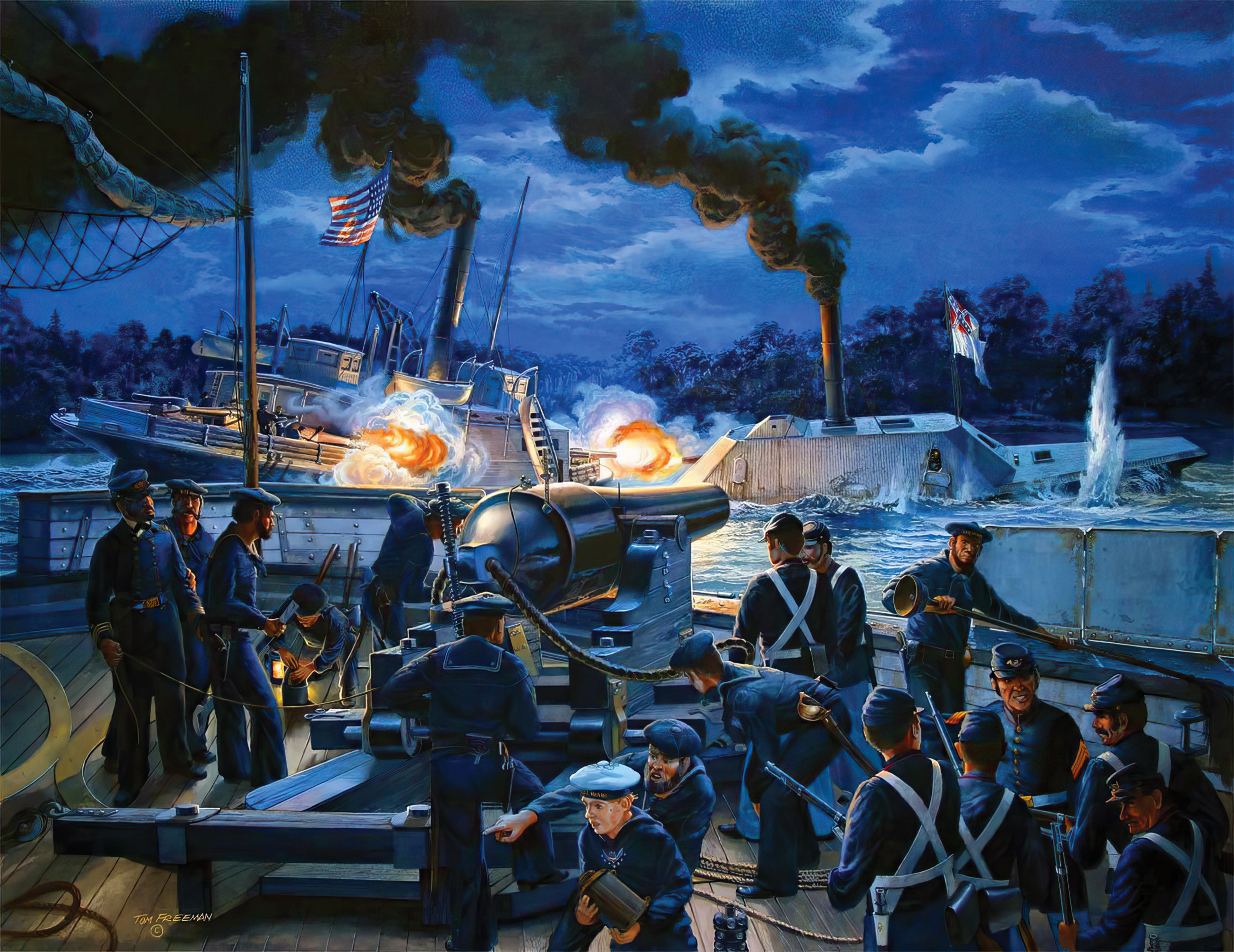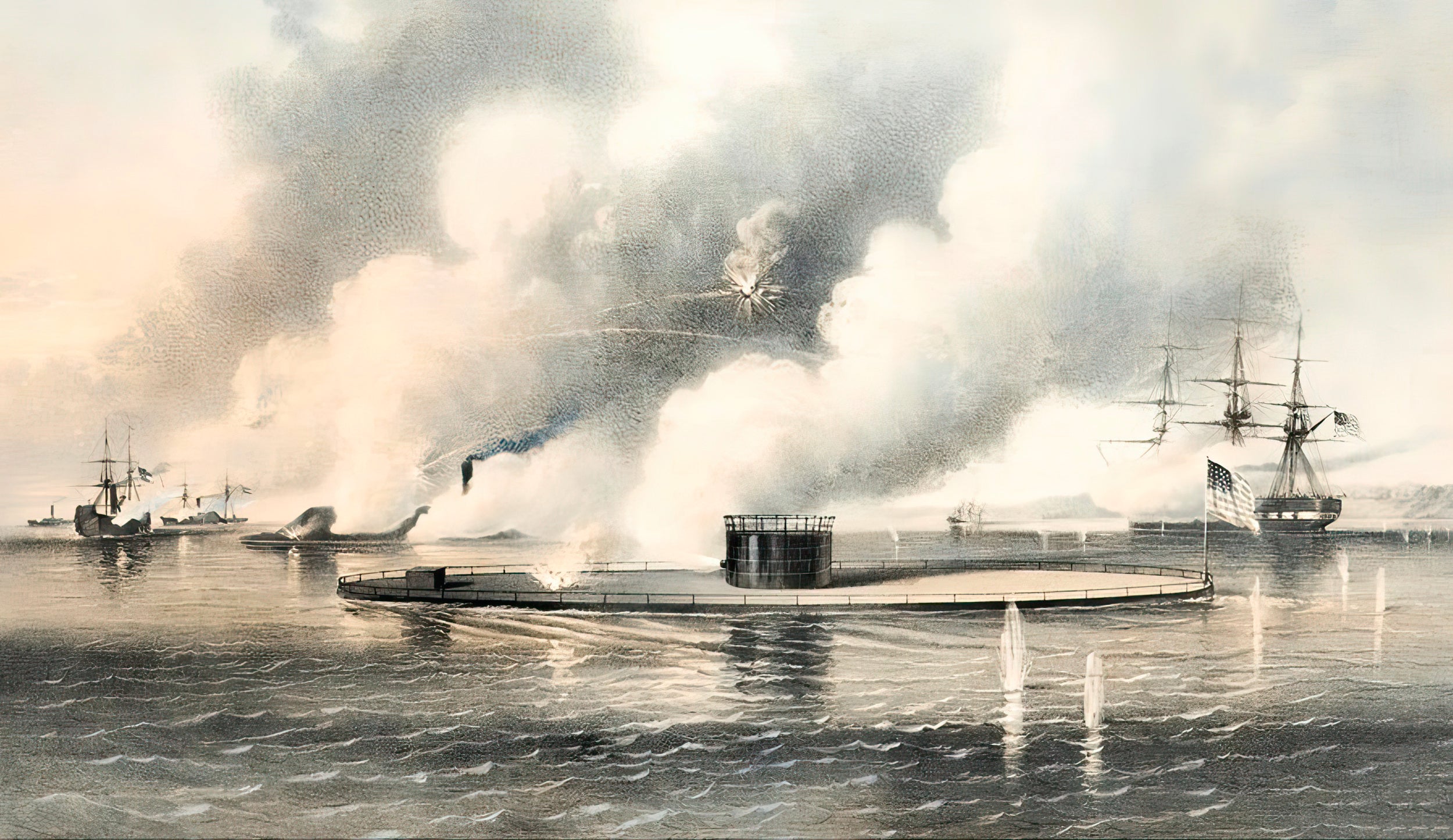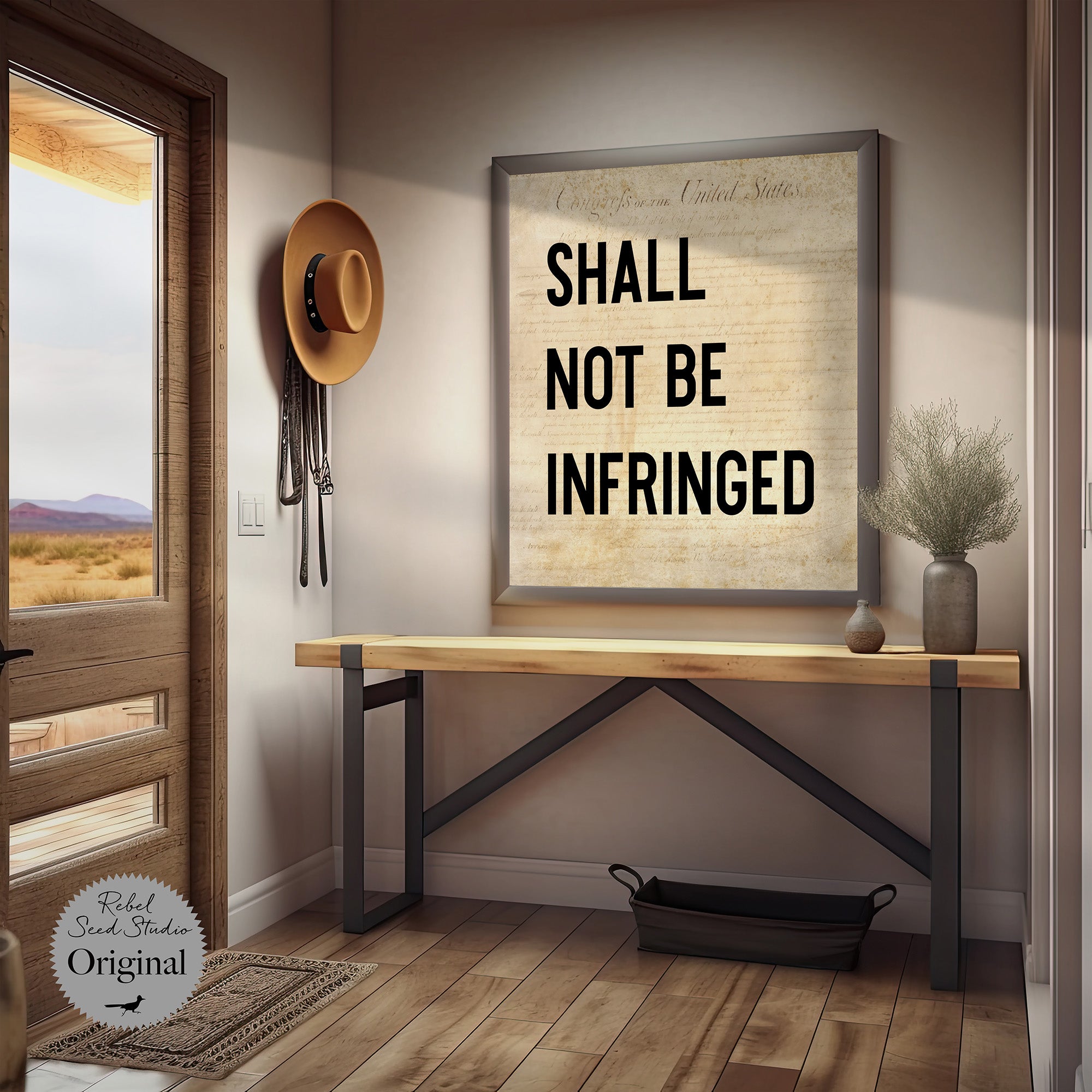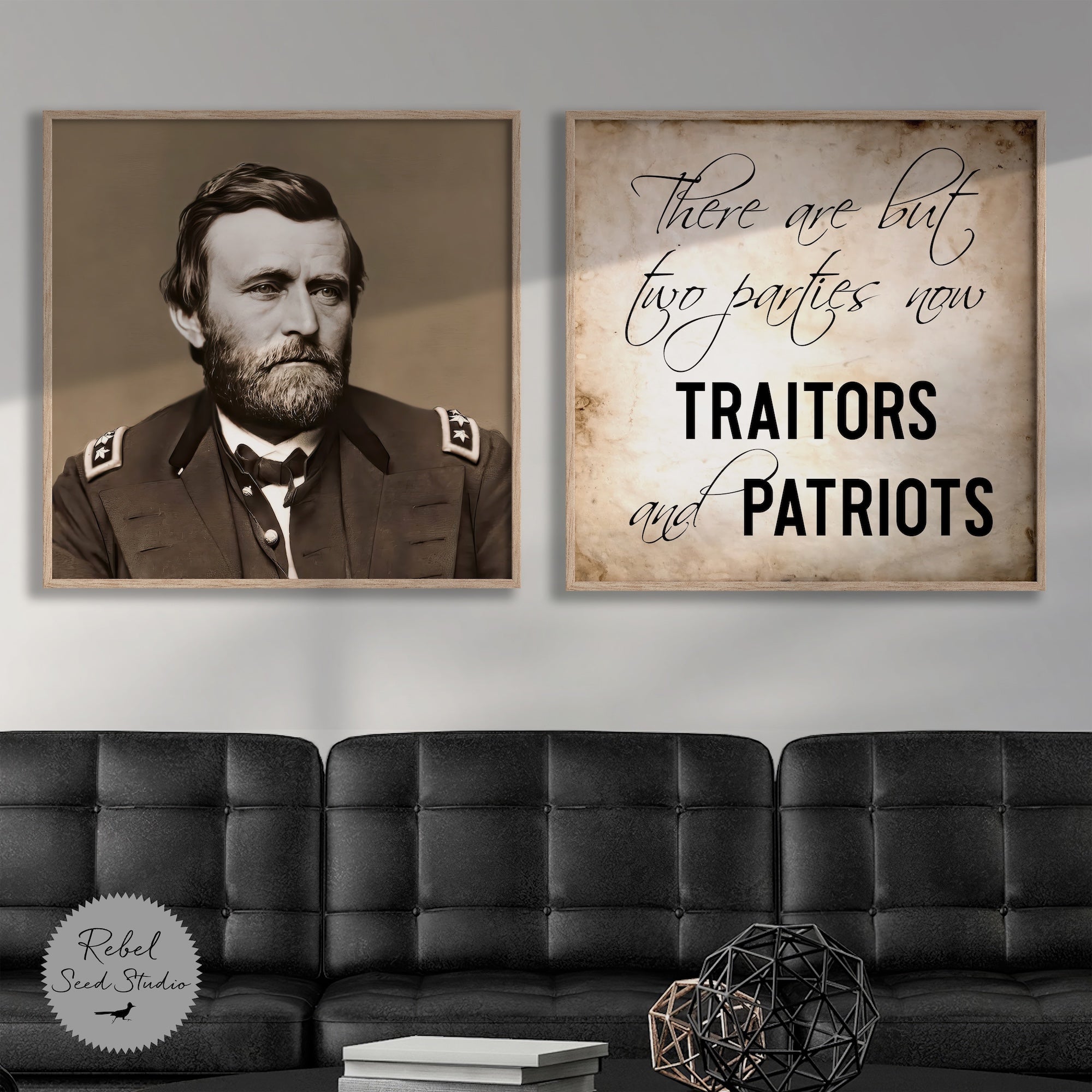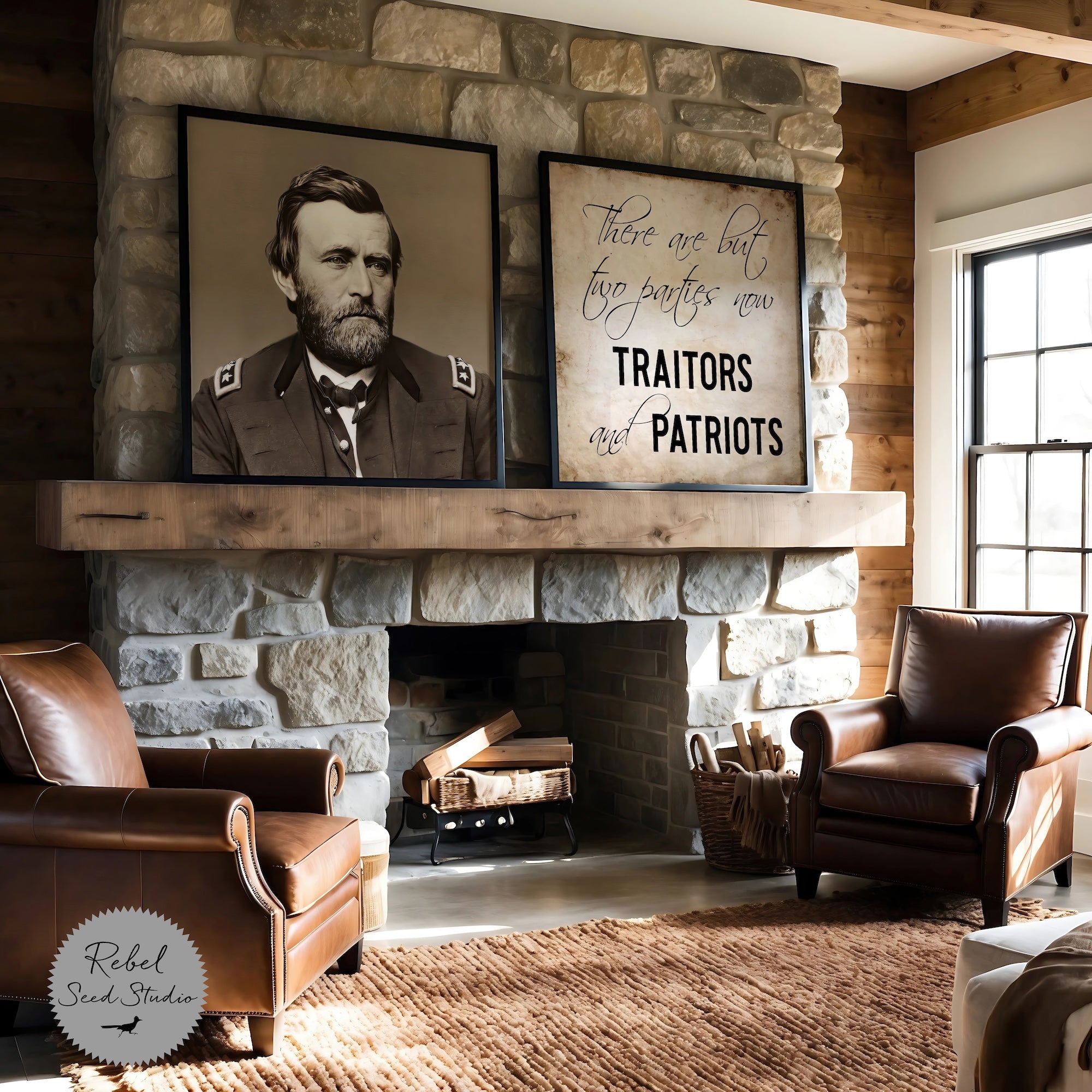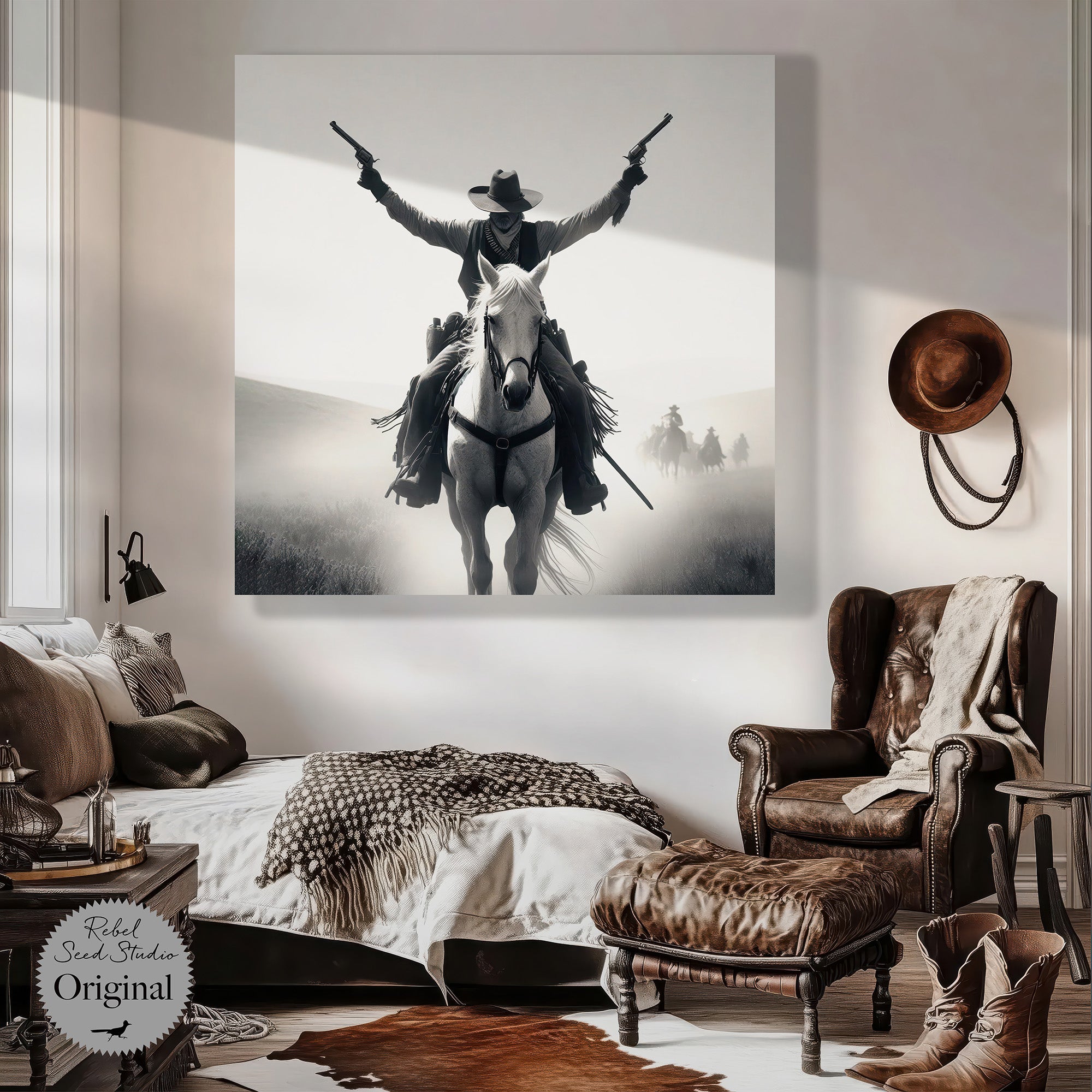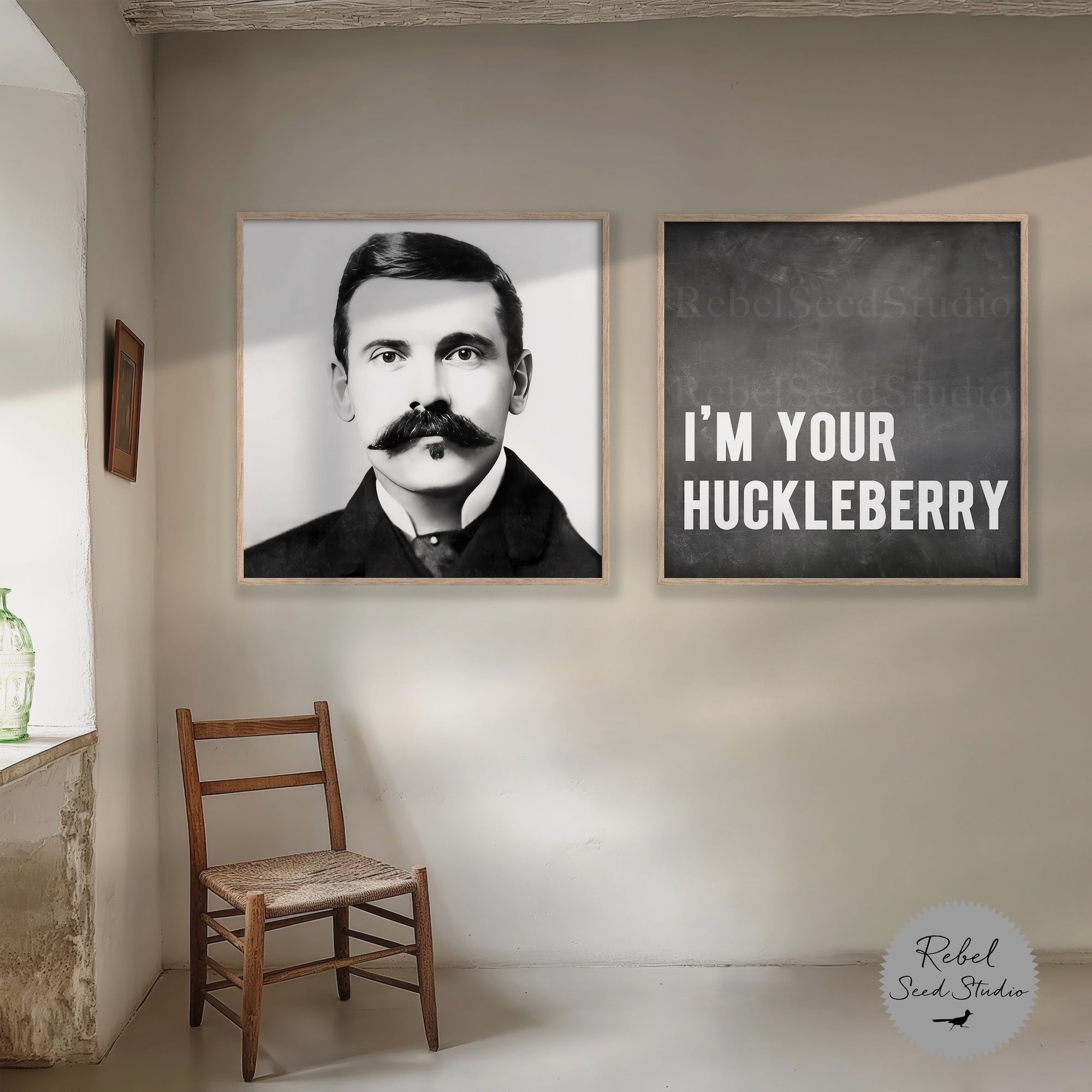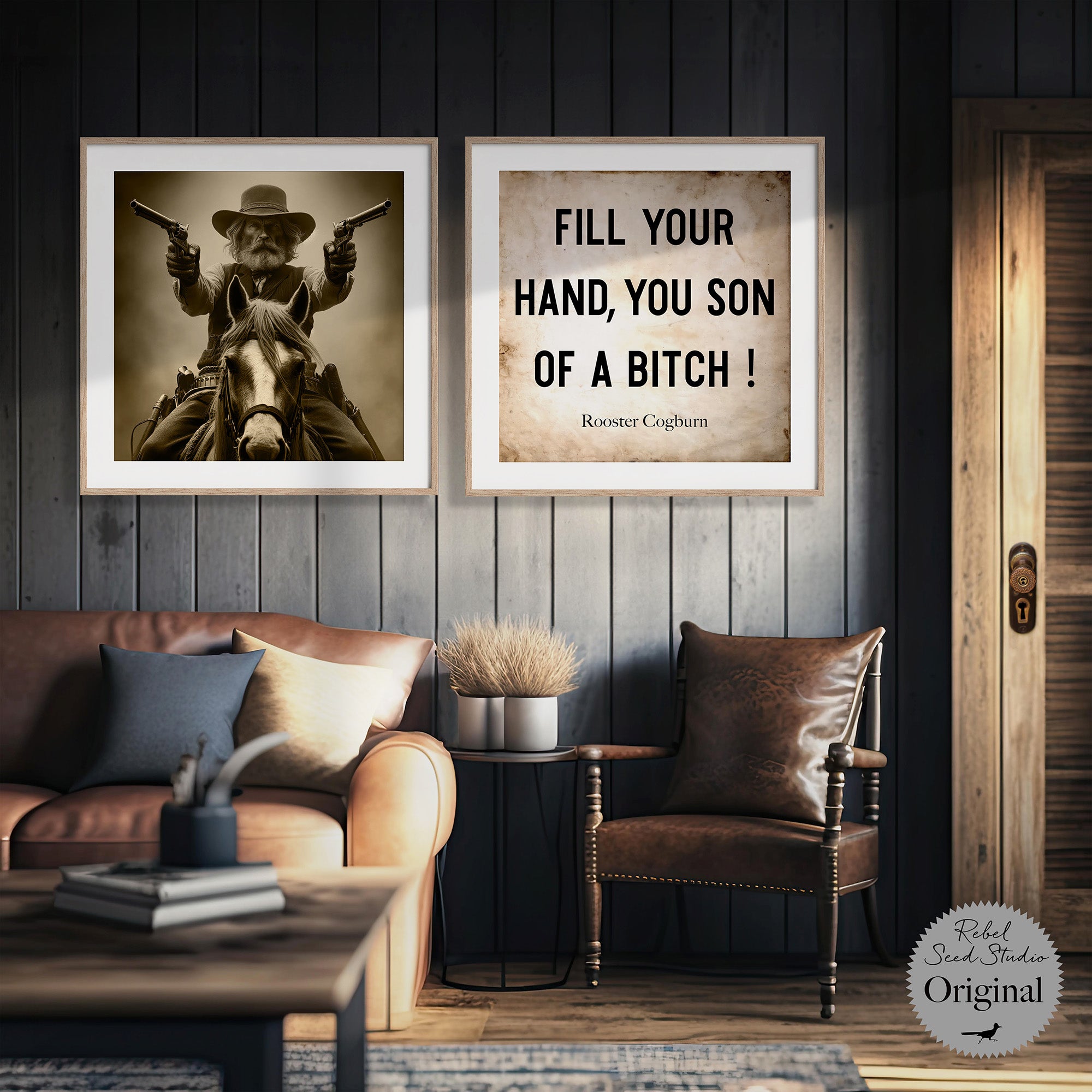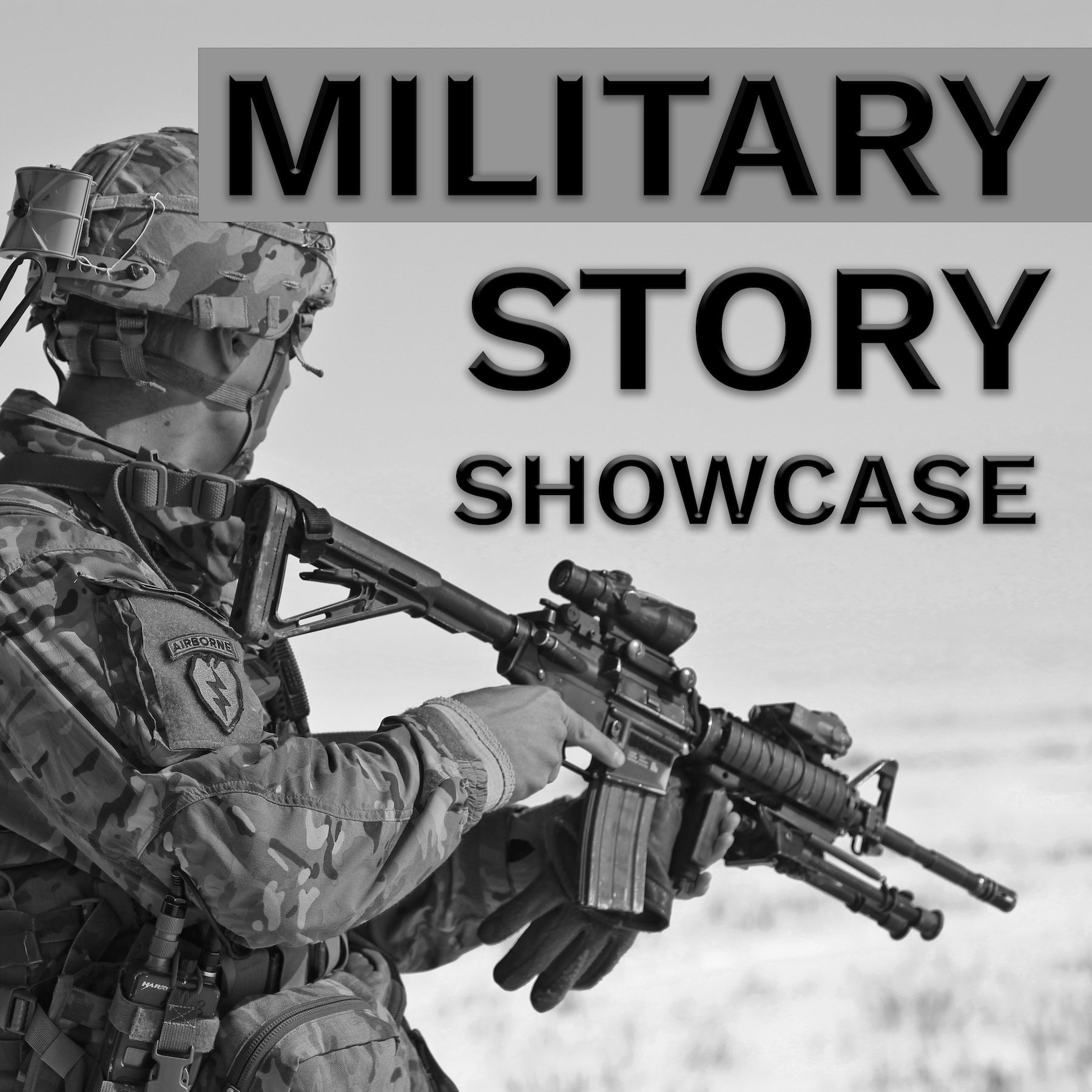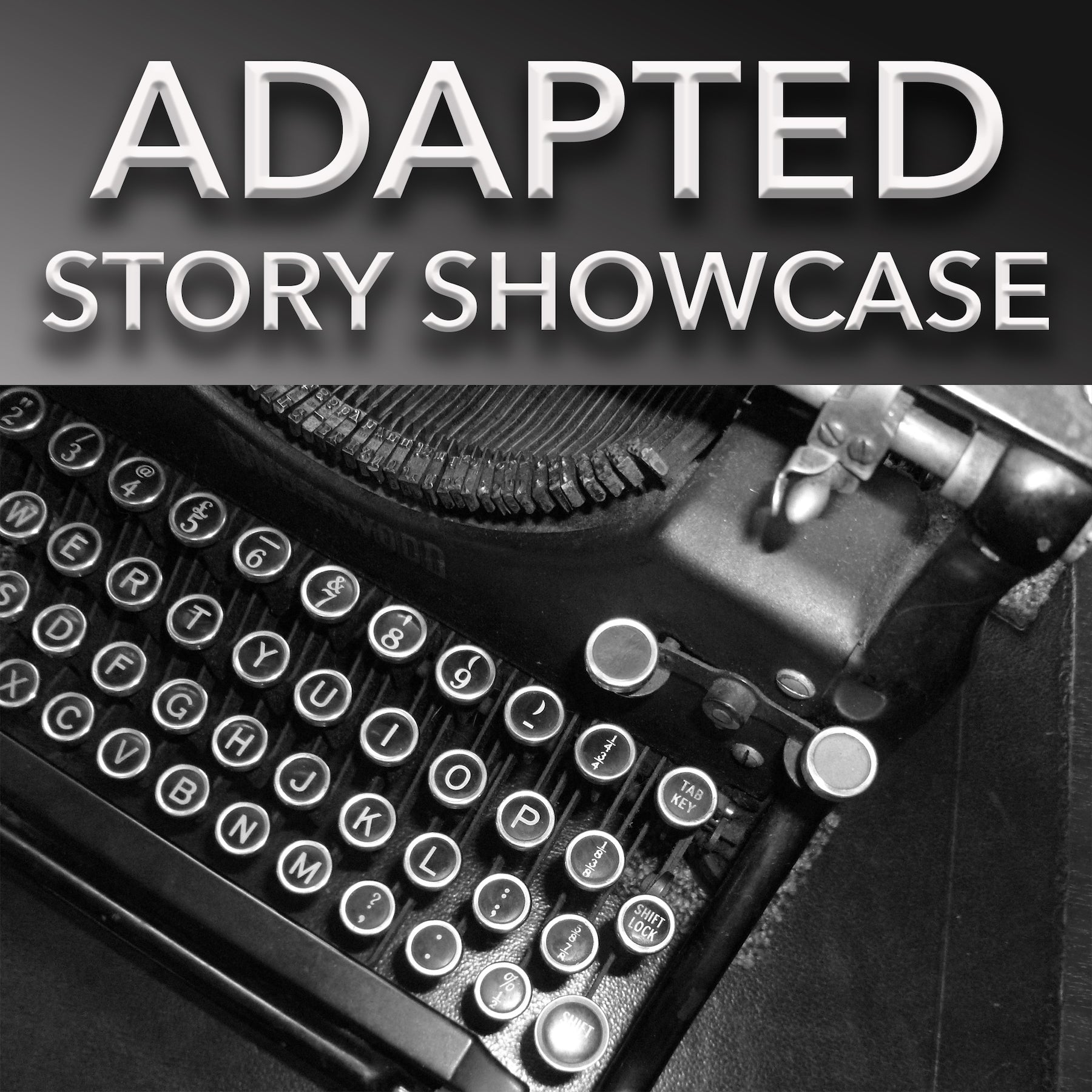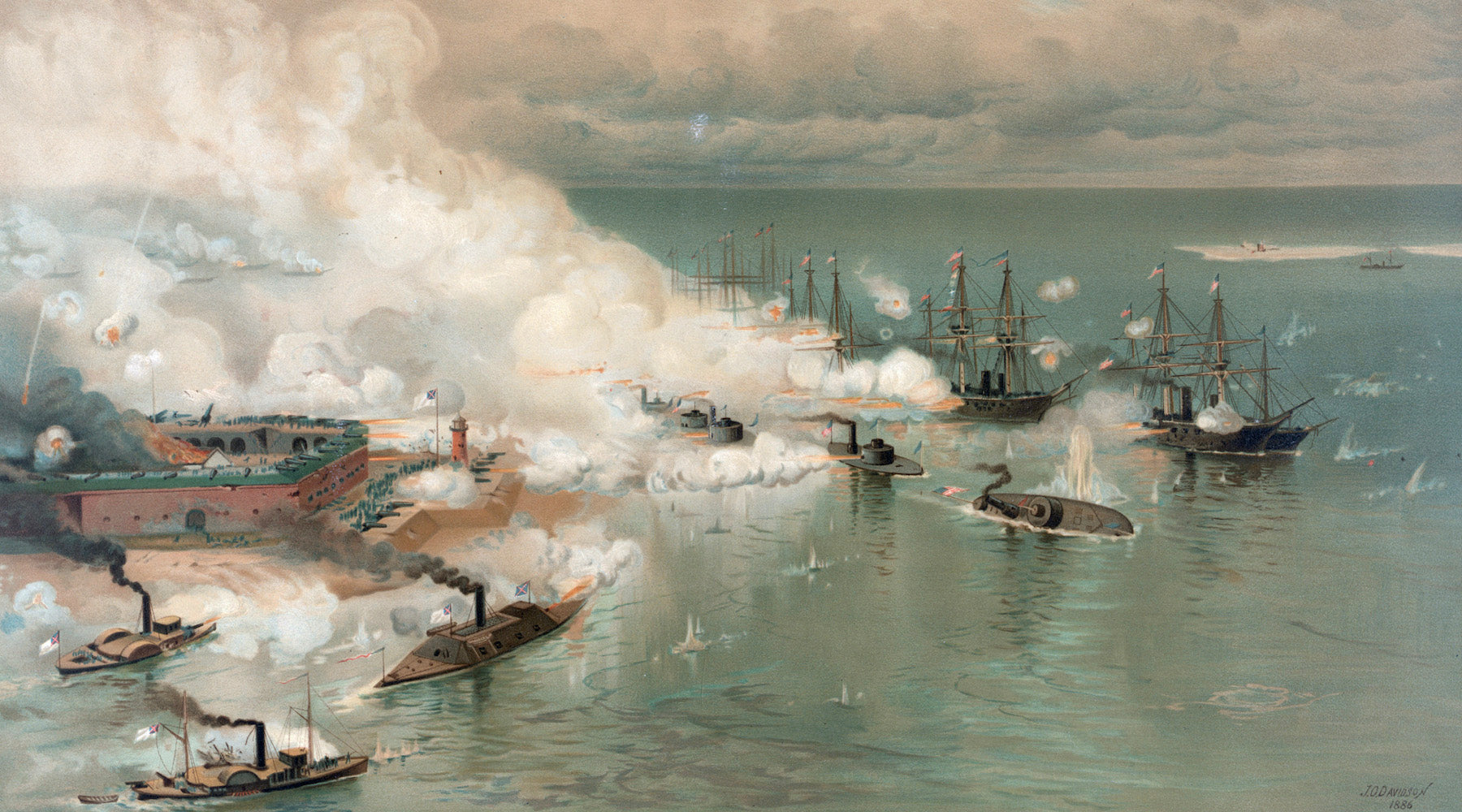
Farragut at Mobile Bay (Historical Reprint)
Historical article reprinted from the book "Hero Tales from American History" written by Theodore Roosevelt in 1895.
Ha, old ship, do they thrill,
The brave two hundred scars
You got in the river wars?
That were leeched with clamorous skill
(Surgery savage and hard),
At the Brooklyn Navy Yard.
* * * *
How the guns, as with cheer and shout,
Our tackle-men hurled them out,
Brought up in the waterways...
As we fired, at the flash
'Twas lightning and black eclipse
With a bellowing sound and crash.
* * * *
The Dahlgrens are dumb,
Dumb are the mortars;
Never more shall the drum
Beat to colors and quarters--
The great guns are silent.
- Henry Howard Brownell
During the Civil War our Navy produced, as it has always produced in every war, scores of capable officers, of brilliant single-ship commanders, of men whose daring courage made them fit leaders in any hazardous enterprise. In this respect the Union seamen in the Civil War merely lived up to the traditions of their service. In a service with such glorious memories it was a difficult thing to establish a new record in feats of personal courage or warlike address. Biddle, in the Revolutionary War, fighting his little frigate against a ship of the line until she blew up with all on board, after inflicting severe loss on her huge adversary; Decatur, heading the rush of the boarders in the night attack when they swept the wild Moorish pirates from the decks of their anchored prize; Lawrence, dying with the words on his lips, "Don't give up the ship"; and Perry, triumphantly steering his bloody sloop-of-war to victory with the same words blazoned on his banner. Men ;like these, and like their fellows, who won glory in desperate conflicts with the regular warships and heavy privateers of England and France, or with the corsairs of the Barbary States, left behind a reputation which was hardly to be dimmed, though it might be emulated, by later feats of mere daring.
But vital though daring is, indispensable though desperate personal prowess and readiness to take chances are to the makeup of a fighting Navy, other qualities are needed in addition to fit a man for a place among the great sea captains of all time. It was the good fortune of the Navy in the Civil War to produce one admiral of renown, one peer of all the mighty men who have ever waged war on the ocean. Farragut was not only the greatest admiral since Nelson, but, with the sole exception of Nelson, he was as great an admiral as ever sailed the broad or the narrow seas.
David Glasgow Farragut was born in Tennessee. He was appointed to the Navy while living in Louisiana, but when the war came he remained loyal to the Union flag. This puts him in the category of those men who deserved best of their country in the Civil War, the men who were Southern by birth, but who stood loyally by the Union; the men like General Thomas of Virginia, and like Farragut's own flag-captain at the Battle of Mobile Bay, Drayton of South Carolina. It was an easy thing in the North to support the Union, and it was a double disgrace to be, like Vallandigham and the Copperheads, against it - and in the South there were a great multitude of men, as honorable as they were brave, who, from the best of motives, went with their States when they seceded, or even advocated secession. But the highest and loftiest patriots, those who deserved best of the whole country, were the men from the South who possessed such heroic courage, and such lofty fealty to the high ideal of the Union, that they stood by the flag when their fellows deserted it, and unswervingly followed a career devoted to the cause of the whole nation and of the whole people.
Among all those who fought in this, the greatest struggle for righteousness which the present century has seen, these men stand preeminent, and among them Farragut stands first. It was his good fortune that by his life he offered an example, not only of patriotism, but of supreme skill and daring in his profession. He belongs to that class of commanders who possess in the highest ;degree the qualities of courage and daring, of readiness to assume responsibility, and of willingness to run great risks; the qualities without which no commander, however cautious and able, can ever become really great. He possessed also the unwearied capacity for taking thought in advance, which enabled him to prepare for victory before the day of battle came, and he added to this an inexhaustible fertility of resource and presence of mind under no matter what strain.
His whole career should be taught to every American schoolboy, for when that schoolboy becomes a voter he should have learned the lesson that the United States, while it ought not to become an overgrown military power, should always have a first-class Navy, formidable from the number of its ships, and formidable still more from the excellence of the individual ships and the high character of the officers and men. Farragut saw the War of 1812, in which, though our few frigates and sloops fought some glorious actions, our coasts were blockaded and ;insulted, and the Capitol at Washington burned, because our statesmen ;and our people had been too short-sighted to build a big fighting Navy - and Farragut was able to perform his great feats on the Gulf coast because, when the Civil War broke out, we had a Navy which, though too small in point of numbers, was composed of ships as good as any afloat.
Another lesson to be learned by a study of his career is that no man in a profession so highly technical as that of the Navy can win a great success unless he has been brought up in and specially trained for that profession, and has devoted his life to the work. This fact was made plainly evident in the desperate hurly-burly of the night battle with the Confederate flotilla below New Orleans - the incidents of this hurly-burly being, perhaps, best described by the officer who, in his report of his own share in it, remarked that "all sorts of things happened".
Of the Confederate rams there were two commanded by trained officers formerly in the United States Navy, Lieutenants Kennon and Warley. Both of these men handled their little vessels with remarkable courage, skill, and success, fighting them to the last, and inflicting serious and heavy damage upon the Union fleet. The other vessels of the flotilla were commanded by men who had not been in the regular Navy, who were merely Mississippi River captains, and the like. These men were, doubtless, naturally as brave as any of the regular officers but, with one or two exceptions, they failed ignobly in the time of trial, and showed a fairly startling contrast with the regular naval officers beside or against whom they fought. This is a fact which may well be pondered by the ignorant or unpatriotic people who believe that the United States does not need a Navy, or that it can improvise one, and improvise officers to handle it, whenever the moment of need arises.
When a boy, Farragut had sailed as a midshipman on the Essex in her famous cruise to the South Pacific, and lived through the murderous fight in which, after losing three fifths of her crew, she was captured by two British vessels. Step by step he rose in his profession, but never had an opportunity of distinguishing himself until, when he was 60 years old, the Civil War broke out. He was then made flag officer of the Gulf squadron, and the first success which the Union forces met with in the southwest was scored by him, when one night he burst the iron chains which the Confederates had stretched across the Mississippi, and, stemming the swollen flood with his splendidly-handled steam-frigates, swept past the forts, sank the rams and gunboats that sought to bar his path, and captured the city of New Orleans.
After further exciting service on the Mississippi, service in which he turned a new chapter in the history of naval warfare by showing the possibilities of heavy seagoing vessels when used on great rivers, he again went back to the Gulf, and, in the last year of the war, was allotted the task of attempting the capture of Mobile, the only important port still left open to the Confederates.
In August, 1864, Farragut was lying with his fleet off Mobile Bay. For months he had been eating out his heart while undergoing the wearing strain of the blockade - sympathizing, too, with every detail of the doubtful struggle on land. "I get right sick, every now and then, at the bad news," he once wrote home, and then again, "The victory of the Kearsarge over the Alabama raised me up. I would sooner have fought that fight than any ever fought on the ocean." As for himself, all he wished was a chance to fight, for he had the fighting temperament, and he knew that, in the long run, an enemy can only be beaten by being out-fought, as well as out-maneuvered. He possessed a splendid self-confidence, and scornfully threw aside any idea that he would be defeated, while he utterly refused to be daunted by the rumors of the formidable nature of the defenses against which he was to act. "I mean to be whipped or to whip my enemy, and not to be scared to death", he remarked in speaking of these rumors.
The Confederates who held Mobile used all their skill in preparing for defense, and all their courage in making that defense good. The mouth of the bay was protected by two fine forts, heavily armed, Morgan and Gaines. The winding channels were filled with torpedoes, and, in addition, there was a flotilla consisting of three gunboats, and, above all, a big ironclad ram, the Tennessee, one of the most formidable vessels then afloat. She was not fast, but she carried six high-power rifled guns, and her armor was powerful, while, being of light draft, she could take a position where Farragut's deep sea ships could not get at her.
Farragut made his attack with four monitors (two of them, the Tecumseh and Manhattan, of large size, carrying 15-inch guns, and the other two, the Winnebago and Chickasaw, smaller and lighter, with 11-inch guns) and the wooden vessels, 14 in number. Seven of these were big sloops-of-war, of the general type of Farragut's own flagship, the Hartford. She was a screw steamer, but was a full rigged ship likewise, with twenty-two 9-inch shell guns, arranged in broadside, and carrying a crew of 300 men. The other seven were light gunboats.
When Farragut prepared for the assault, he arranged to make the attack with his wooden ships in double column. The seven most powerful were formed on the right, in line ahead, to engage Fort Morgan, the heaviest of the two forts, which had to be passed close inshore to the right. The light vessels were lashed each to the left of one of the heavier ones. By this arrangement, each pair of ships was given a double chance to escape if rendered helpless by a shot in the boiler or other vital part of the machinery. The heaviest ships led in the fighting column, the first place being taken by the Brooklyn and her gunboat consort, while the second position was held by Farragut himself in the Hartford, with the little Metacomet lashed alongside. He waited to deliver the attack until the tide and the wind should be favorable, and made all his preparations with the utmost care and thoughtfulness. Preeminently a man who could inspire affection in others, both the officers and men of the fleet regarded him with fervent loyalty and absolute trust.
The attack was made early on the morning of August 5th. Soon after ;midnight the weather became hot and calm, and at three the Admiral learned that a light breeze had sprung up from the quarter he wished, and he at once announced, "Then we will go in this morning." At daybreak he was at breakfast when the word was brought that the ships were all lashed in couples. Turning quietly to his captain, he said, "Well, Drayton, we might as well get under way", and at half-past six the monitors stood down to their stations, while the column of wooden ships was formed, all with the United States flag hoisted, not only at the peak, but also at every masthead.
The four monitors, trusting in their iron sides, steamed in between the wooden ships and the fort. Every man in every craft was thrilling with the fierce excitement of battle, but, in the minds of most, there lurked a vague feeling of unrest over one danger. For their foes who fought in sight, for the forts, the gunboats and the great ironclad ram, they cared nothing, but all, save the very boldest, were at times awed, and rendered uneasy by the fear of the hidden and the unknown. Danger which is great and real, but which is shrouded in mystery, is always awful and the ocean veterans dreaded the torpedoes - the mines of death - which lay, they knew not where, thickly scattered through the channels along which they were to thread their way.
The tall ships were in fighting trim, with spars housed, and canvas furled. The decks were strewn with sawdust. Every man was in his place. The guns were ready, and except for the song of the sounding-lead there was silence in the ships as they moved forward through the glorious morning. It was seven o'clock when the battle began, as the Tecumseh, the leading monitor, fired two shots at the fort. In a few minutes Fort Morgan was ablaze with the flash of her guns, and the leading wooden vessels were sending back broadside after broadside. Farragut stood in the port main rigging, and as the smoke increased he gradually climbed higher, until he was close by the maintop, where the pilot was stationed for the sake of clearer vision. The captain, fearing lest by one of the accidents of battle the great admiral should lose his footing, sent aloft a man with a lasher, and had a turn or two taken around his body in the shrouds, so that he might not fall if wounded, for the shots were flying thick.

At first the ships used only their bow guns, and the Confederate ram, with her great steel rifles, and her three consorts, taking station where they could rake the advancing fleet, caused much loss. In twenty minutes after the opening of the fight, the ships of the van were fairly abreast of the fort, their guns leaping and thundering, and under the weight of their terrific fire that of the fort visibly slackened. All ;was now uproar and slaughter, the smoke drifting off in clouds. The decks were reddened and ghastly with blood, and the wreck of flying splinters drove across them at each discharge. The monitor Tecumseh alone was silent. After firing the first two shots, her commander, Captain Craven, had loaded his two big guns with steel shot, and, thus prepared, reserved himself for the Confederate ironclad, which he had set his heart upon taking or destroying single-handed.
The two columns of monitors and the wooden ships lashed in pairs were now approaching the narrowest part of the channel, where the torpedoes lay thickest, and the guns of the vessels fairly overbore and quelled the fire from the fort. All was well, provided only the two columns could push straight on without hesitation, but just at this moment a terrible calamity befell the leader of the monitors. The Tecumseh, standing straight for the Tennessee, was within 200 yards of her foe, when a torpedo suddenly exploded beneath her. The monitor was about 500 yards from the Hartford, and from the maintop Farragut, looking at her, saw her reel violently from side to side, lurch heavily over, and go down headforemost, her screw revolving wildly in the air as she disappeared. Captain Craven, one of the gentlest and bravest of men, was in the pilot-house with the pilot at the time. As she sank, both rushed to the narrow door, but there was time for only one to get out. Craven was ahead, but drew to one side, saying, "After you, pilot." As the pilot leaped through, the water rushed in, and Craven and all his crew, save two men, settled to the bottom in their iron coffin.
None of the monitors were awed or daunted by the fate of their consort, but drew steadily onward. In the bigger monitors the captains, like the crews, had remained within the iron walls, but on the two light crafts the commanders had found themselves so harassed by their cramped quarters, that they both stayed outside on the deck. As these two steamed steadily ahead, the men on the flagship saw Captain Stevens, of the Winnebago, pacing calmly, from turret to turret, on his unwieldy iron craft, under the full fire of the fort.
The captain of the Chickasaw, Perkins, was the youngest commander in the fleet, and as he passed the Hartford, he stood on top of the turret, waving his hat and dancing about in wildest excitement and delight. But, for a moment, the nerve of the commander of the Brooklyn failed him. The awful fate of the Tecumseh and the sight of a number of objects in the channel ahead, which seemed to be torpedoes, caused him to hesitate. He stopped his ship, and then backed water, making sternway to the Hartford, so as to stop her also. It was the crisis of the fight and the crisis of Farragut's career. The column was halted in a narrow channel, right under the fire of the forts. A few moments' delay and confusion, and the golden chance would have been past, and the only question remaining would have been as to the magnitude of the disaster. Ahead lay terrible danger, but ahead lay also triumph. It might be that the first ship to go through would be sacrificed to the torpedoes. It might be that others would be sacrificed, but go through the fleet must.
Farragut signaled to the Brooklyn to go ahead, but she still hesitated. Immediately, the admiral himself resolved to take the lead. Backing hard he got clear of the Brooklyn, twisted his ship's prow short round, and then, going ahead fast, he dashed close under the Brooklyn's stern, straight at the line of buoys in the channel. As he thus went by the Brooklyn, a warning cry came from her that there were torpedoes ahead.
"Damn the torpedoes!" shouted the admiral, "Go ahead, full speed!" and the Hartford and her consort steamed forward.
As they passed between the buoys, the cases of the torpedoes were heard knocking against the bottom of the ship, but for some reason they failed to explode, and the Hartford went safely through the gates of Mobile Bay, passing the forts. Farragut's last and hardest battle was virtually won. After a delay which allowed the flagship to lead nearly a mile, the Brooklyn got her head round and came in, closely followed by all the other ships. The Tennessee strove to interfere with the wooden craft as they went in, but they passed, exchanging shots, and one of them striving to ram her, but inflicting only a glancing blow. The ship on the fighting side of the rear couple had been completely disabled by a shot through her boiler.
As Farragut got into the bay he gave orders to slip the gunboats, which were lashed to each of the Union ships of war, against the Confederate gunboats, one of which he had already disabled by his fire, so that she was run ashore and burnt. Jouett, the captain of the Metacomet, had been eagerly waiting this order, and had his men already standing at the hawsers, hatchet in hand. When the signal for the gunboats to chase was hoisted, the order to Jouett was given by word of mouth, and as his hearty "Aye, aye, sir," came in answer, the hatchets fell, the hawsers parted, and the Metacomet leaped forward in pursuit. A thick rainsquall came up, and rendered it impossible for the rear gunboats to know whither the Confederate flotilla had fled. When it cleared away, the watchers on the fleet saw that one of the two which were uninjured had slipped off to Fort Morgan, while the other, the Selma, was under the guns of the Metacomet, and was promptly carried by the latter.
Meanwhile, the ships anchored in the bay about four miles from Fort Morgan, and the crews were piped to breakfast, but almost as soon as it was begun, the lookouts reported that the great Confederate ironclad was steaming down to do battle, single-handed, with the Union fleet. She was commanded by Buchanan, a very gallant and able officer, who had been on the Merrimac, and who trusted implicitly in his invulnerable sides, his heavy rifle guns, and his formidable iron beak. As the ram came on, with splendid courage, the ships got under way, while Farragut sent word to the monitors to attack the Tennessee at once. The fleet surgeon, Palmer, delivered these orders. In his diary he writes:
"I came to the Chickasaw, happy as my friend Perkins habitually is, I thought he would turn a somerset with joy, when I told him, 'The admiral wants you to go at once and fight the Tennessee.'"
At the same time, the admiral directed the wooden vessels to charge the ram, bow on at full speed, as well as to attack her with their guns. The monitors were slow, and the wooden vessels began the attack. The first to reach the hostile ironclad was the Monongahela, which struck her square amidships, and five minutes later the Lackawanna, going at full speed, delivered another heavy blow. Both the Union vessels fired such guns as would bear as they swung round, but the shots glanced harmlessly from the armor, and the blows of the ship produced no serious injury to the ram, although their own stems were crushed in several feet above and below the water line.
The Hartford then struck the Tennessee, which met her bows on. The two antagonists scraped by, their port sides touching. As they rasped past, the Hartford's guns were discharged against the ram, their muzzles only half a dozen feet distant from her iron-clad sides, but the shot made no impression. While the three ships were circling to repeat the charge, the Lackawanna ran square into the flagship, cutting the vessel down to within two feet of the water. For a moment, the ship's company thought the vessel sinking, and almost as one man they cried: "Save the admiral! Get the admiral on board the Lackawanna." But Farragut, leaping actively into the chains, saw that the ship was in no present danger, and ordered her again to be headed for the Tennessee.
Meanwhile, the monitors had come up, and the battle raged between them and the great ram. Like the rest of the Union fleet, they carried smooth-bores, and their shot could not break through her iron plates, but by sustained and continuous hammering, her frame could be jarred and her timbers displaced. Two of the monitors had been more or less disabled already, but the third, the Chickasaw, was in fine trim, and Perkins got her into position under the stern of the Tennessee, just after the latter was struck by the Hartford, and there he stuck to the end, never over 50 yards distant, and keeping up a steady rapping of 11-inch shot upon the iron walls, which they could not penetrate, but which they racked and shattered.
The Chickasaw fired 52 times at her antagonist, shooting away the exposed rudder-chains and the smokestack, while the commander of the ram, Buchanan, was wounded by an iron splinter which broke his leg. Under the hammering, the Tennessee became helpless. She could not be steered, and was unable to bring a gun to bear, while many of the shutters of the ports were jammed. For 20 minutes she had not fired a shot. The wooden vessels were again bearing down to ram her, and she hoisted the white flag.
Thus ended the Battle of Mobile Bay, Farragut's crowning victory. Less than three hours elapsed from the time that Fort Morgan fired its first gun to the moment when the Tennessee hauled down her flag. Three hundred and thirty-five men had been killed or wounded in the fleet, and one vessel, the Tecumseh, had gone down, but the Confederate flotilla was destroyed, the bay had been entered, and the forts around it were helpless to do anything further. One by one they surrendered, and the port of Mobile was thus sealed against blockade runners, so that the last source of communication between the Confederacy and the outside world was destroyed. Farragut had added to the annals of the Union the page which tells of the greatest sea-fight in our history.


